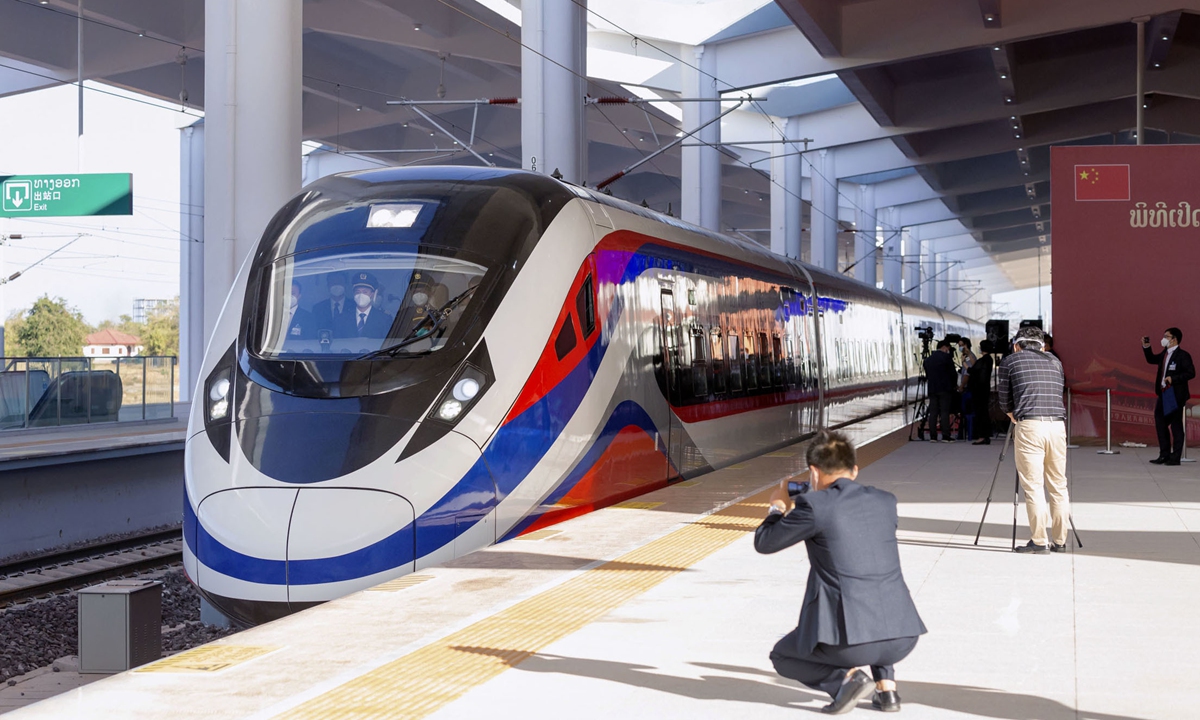
The first international cargo train along the 1,035-kilometer China-Laos Railway arrives in Vientiane, Laos,on December 4, 2021. Photo: VCG
The China-Laos Railway celebrated the 100th day of operation on Saturday, having carried more than 1.2 million tons of goods and injected fresh momentum into economic and trade cooperation between China and ASEAN, officials and analysts noted.
Since the
operation of the line began on December 12, 2021, 13 Chinese provincial-level regions, including Beijing and East China's Shandong, Zhejiang and Jiangsu have sent more than 360 cross-border cargo trains, exporting goods to the 10 ASEAN members, such as Laos, Myanmar, Cambodia and Thailand.
The railway has become a convenient logistics channel between China and ASEAN. Through the railway, China has imported more than 120,000 tons of goods with a value of more than 500 million yuan ($78.8 million) and exported more than 70,000 tons of goods with a value of over 1.7 billion yuan, according to official data.
"The major progress of the rail line demonstrates the pragmatic cooperation between China and ASEAN countries, promoting connectivity between China and neighboring countries," Xu Liping, director of the Center for Southeast Asian Studies at the Chinese Academy of Social Sciences in Beijing, told the Global Times on Sunday.
In addition to the rising freight volume, the types of goods transported have expanded from rubber and fertilizer to encompass electronics, photovoltaic products, automobiles, textiles, vegetables, flowers and other products.
"With the Regional Comprehensive Economic Partnership (RCEP) taking effect from January 1, the types of goods will become more varied. China is expected to import a large number of tropical fruits like bananas and durians from ASEAN members, including Thailand," Xu predicted.
The railway has significantly reduced the transportation time and cost for shipments. In order to improve the quality of freight transportation between China and Laos, the two countries started a direct cargo train carrying mainly fruits and vegetables, which takes only 26 hours to travel from Kunming, Southwest China's Yunnan Province to Vientiane, capital of Laos, shorter than the normal international cargo train operating time.
According to a World Bank report, the railway will reduce freight costs from Vientiane to Kunming by 40-50 percent, while freight costs on domestic routes in Laos will be reduced by 20-40 percent.
As freight volume on the China-Laos Railway continues to rise, its passenger transportation is also growing steadily.
During the 100 days of operation, ridership exceeded 1.8 million trips. The Chinese section operated 23.5 pairs of trains per day, transporting more than 1.65 million passengers in total, while the Lao section operated two pairs, carrying more than 150,000 passengers.
The railway is also helping deepen cooperation between China and Laos in various areas. In September 2021, the power supply project for the China-Laos Railway was put into operation, aiming at ensuring the smooth operation of the railway. The project was built by the Laos-China Power Investment Co, co-sponsored by China Southern Power Grid and Électricité du Laos.
On March 9, the Chinese Embassy in Laos said that the two companies
signed an electricity agreement, in a bid to address local long-abandoned water and power generation facilities, as well as promoting green development in both countries.
Xu noted that Laos, as a "battery storage" among ASEAN members, enjoys rich electricity resources but its grid construction is lagging, adding that energy cooperation between the two countries will help Laos improve its power supply and promote the export of surplus electricity from the country.
In addition to transportation and electricity, the two countries are also expected to step up cooperation in many other fields such as industry, energy, agriculture and the digital economy.
In 2021, China-Laos bilateral trade totaled $4.35 billion, up 21.4 percent from the previous year, data from the General Administration of Customs showed.




